
|
The Last Temptation of Christ
(1988)
In Martin Scorsese's unorthodox and profound film -
adapted from the novel of the same name by Nikos Kazantzakis:
- the scene of Nazarene Jesus Christ's (Willem Dafoe)
angry outburst at the moneychangers in the temple and his confrontation
with the rabbis-priests: ("This is my Father's house! It's
a place of worship, not a market!...God doesn't need a palace.
He doesn't need cypress trees or dead animals! He doesn't need
shekles!"), and then his anger at one of the rabbis: "I'm
throwing away the law. I have a new law and a new hope....How can
I presume? Because I'm the end of the old law and the beginning
of the new one....When I say 'I' Rabbi, I'm saying 'God.'...Didn't
they tell you? I'm the saint of blasphemy. Don't make any mistakes,
I didn't come here to bring peace, I came to bring a sword!...Me
killed? Listen to me. This temple will be destroyed in three days,
torn down to the ground! There won't be one stone left to build
with! You think God belongs only to you? He doesn't. God's an immortal
spirit who belongs to everybody - to the whole world! You think
you're special? God is not an Israelite!"
- the pre-crucifixion scene of Jesus' appearance before
Pilate, his beating/scourging and placement of a crown of thorns
on his head, and his lengthy, slow-motion walk through Jerusalem's
streets and mocking crowds to Golgotha
- the moment when the cross was raised into an upright
position (with the camera mounted upon it)
- and then the moment that Jesus, naked and hanging
on the cross during crucifixion, cried out as the camera turned
sideways: "Father! Why have You forsaken me?"
- the controversial "last temptation" visionary
sequence in which Jesus was tempted by Satan (portrayed as a young
androgynous guardian angel (Juliette Caton)); his crown of thorns
was removed, as well as the spikes through his feet and wrists; he
was given life and led away from an empty cross while he asked doubtfully: "I
don't have to be sacrificed?...I'm not the Messiah"; onlookers
at Golgotha didn't seem to notice his departure
- the sequence in which Jesus was provided with visions
of a "normal" earthly life, including the blasphemous idea
(his "last temptation") of a sexual relationship with a
woman - with tattooed Jewish prostitute Mary Magdalene (Barbara Hershey);
he was immediately married to her - he was earlier seen entertaining
various clients in a brothel where Jesus had spoken with her and
asked her for forgiveness. [She offered herself to him: "Here's
my body. Save it. Save it," but he declined to be enticed by
her before leaving for the desert.] Now married to him, she cleansed
his bloody wounds as he laid naked in her arms, and then, in a non-exploitative
sequence, Jesus made tender, physical love with her as she entreated: "We
could have a child"
Sexual Relationship with Mary Magdalene
- Resulting in Pregnancy
|
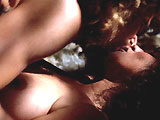
|
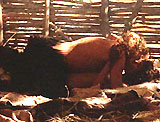
|
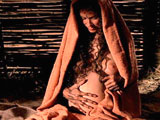
|
- ultimately, however, after discussions with the
apostle Paul (Harry Dean Stanton) ("Their only hope is the
resurrected Jesus!...You see, you don't know how much people need
God. You don't know how happy he can make them. He can make them
happy to do anything. He can make them happy to die and they'll
die. All for the sake of Christ. Jesus Christ. Jesus of Nazareth.
The Son of God. The Messiah. Not you. Not for your sake. You know,
I'm glad I met you. Because now I can forget all about you. My
Jesus is much more important and much more powerful"), and
another intervention with Judas Iscariot (Harvey Keitel), Jesus
returned to the cross to suffer for humanity's sake - the temptation
was ultimately rejected by Jesus -- with his triumphant dying words:
"It is accomplished"
|
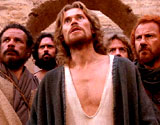
Jesus' Angry Blasphemous Outburst at the Moneychangers
in the Temple and Rabbis

Placement of Crown of Thorns
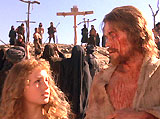
Visionary Sequence During Crucifixion: Jesus Was
Tempted by Guardian Angel
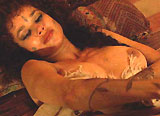
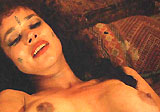


Tattooed Prostitute
Mary Magdalene (Barbara Hershey)

Apostle Paul to Jesus: "Their only hope is the resurrected
Jesus"
|









